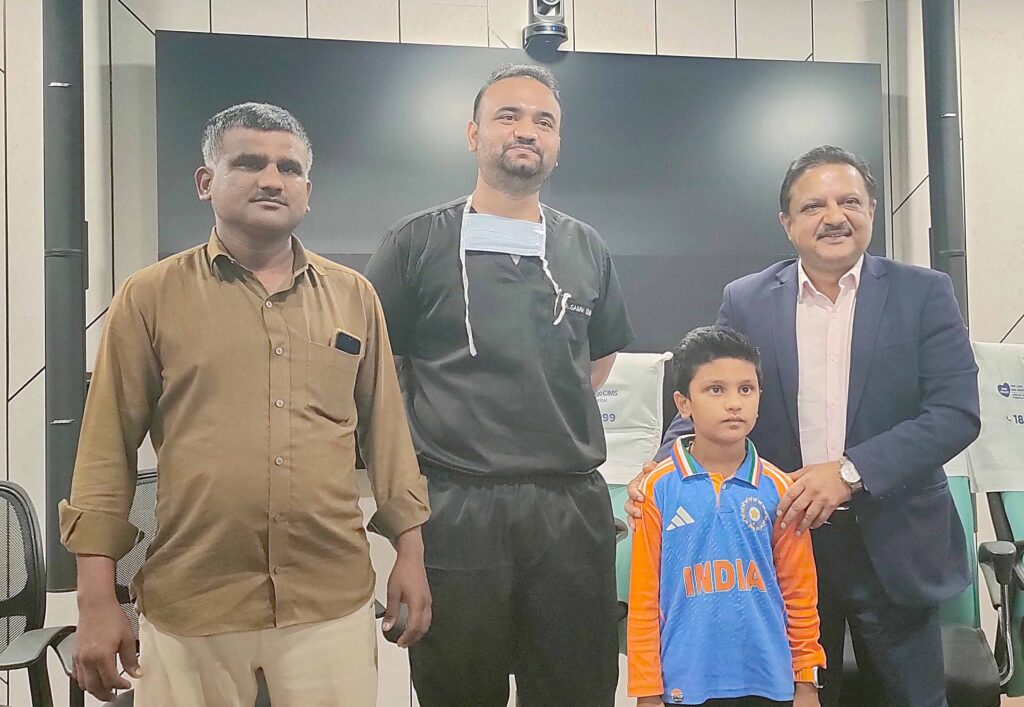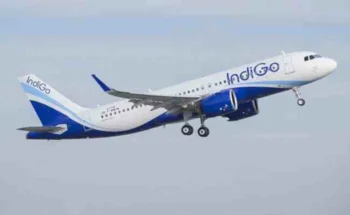Marengo CIMS Hospital Achieves Landmark Success in Pediatric Cardiac Surgery

First Use of Fluorescence Guided Surgery for Thoracoscopic Left Cardiac Sympathetic Denervation (LCSD) in India
- The Fluorescence-Guided Surgery at Marengo CIMS Hospital offers new hope for Children with Life-Threatening CPVT-2
- The state-of-the-art thoracic department focuses on personalized patient care with multidisciplinary support, for comprehensive treatment plans that integrate surgical, oncological, and rehabilitation services
Ahmedabad: Wednesday, 9th October 2024: Marengo CIMS Hospital Ahmedabad achieved a major milestone in pediatric cardiac care by performing India’s first Thoracoscopic fluorescence-guided surgery (FGS) for Left Cardiac Sympathetic Denervation (LCSD). The patient was an 8-year-old boy diagnosed with Autosomal Recessive Catecholaminergic Polymorphic Ventricular Tachycardia-Type 2 (CPVT-2).
This pioneering procedure represents a significant advancement in the treatment of this rare and life-threatening condition, offering new hope to patients and families facing complex cardiac challenges. The Cardiac arrhythmia department in Marengo CIMS Hospital is led by Dr Ajay Naik, Cardiac Electrophysiologist, Director of Cardiac Arrhythmia & HF Device Division, and the Thoracic Surgery department is led by Dr Sarav Shah, Consultant Thoracic Surgeon, Marengo CIMS Hospital.
The young patient had been experiencing recurrent episodes of syncope and loss of consciousness due to extremely rapid Bidirectional ventricular tachycardia (VTs) and Polymorphic VT. Bidirectional ventricular tachycardia (VT) is a rare type of abnormal heart rhythm (arrhythmia) characterized by rapid alternating electrical activity in the heart’s ventricles. Polymorphic VT is a type of ventricular tachycardia (VT) where the heart’s ventricles are activated in an extremely rapid, irregular manner.
Both Bidirectional Ventricular Tachycardia (BVT) and Polymorphic Ventricular Tachycardia (PVT) represent serious cardiac arrhythmias, each posing significant risks to heart function and potentially leading to life-threatening complications, particularly if not recognized and treated promptly.
Diagnosis and evaluation by Dr Ajay Naik revealed the genetic cause of the disease – a deletion in the CASQ2 gene, confirming the diagnosis of CPVT-2. The patient was started on oral medications, which helped reduce the frequency and severity of the episodes. However, drugs are not 100% effective in the treatment of this type of case.
Dr Naik referred the case to Dr Sarav Shah for conducting the highly specialized and delicate LCSD procedure. The LCSD (Left Cardiac Sympathetic Denervation) procedure is a surgical intervention used to treat certain life-threatening cardiac arrhythmias, particularly in patients with inherited heart rhythm disorders or conditions that lead to an increased risk of sudden cardiac arrest.
This procedure involves disrupting the sympathetic nerves that supply the heart, specifically targeting the left side of the sympathetic nervous system, which has a strong influence on heart rate and arrhythmia generation. Given the complexity of the surgery, there is a high risk of complications, including Horner’s syndrome.
To ensure precision and mitigate risks, Dr Sarav utilized fluorescence-guided surgery (FGS) with Indocyanine Green (ICG) dye, a most advanced technique that enabled the clear identification and illumination of the sympathetic nerve structures. This allowed the surgical team to perform the procedure with enhanced accuracy, significantly reducing the risk of nerve damage. The procedure was further supported by advanced laparoscopic equipment and an advanced Stryker 1688 Laparoscopy system. The patient was discharged just 48 hours post-surgery, a testament to the efficacy of this innovative technique.
Dr. Ajay Naik, Cardiac Electrophysiologist and Director of the Cardiac Arrhythmia & Heart Failure Device Division says, “This case presented significant challenges due to the complexity of the arrhythmias and the life-threatening nature of CPVT-2. Fluorescence-guided surgery provided a level of precision previously unattainable in procedures like this. Medications alone are insufficient for managing such conditions, and the use of an Implantable Defibrillator poses substantial difficulties in young patients. The success of this surgery not only brings new hope to the patient and his family but also sets a precedent for the future management of similar cases.”
Dr. Sarav Shah, Consultant Thoracic Surgeon, remarked, “This surgery marks a major milestone in paediatric cardiac care in India. By utilizing Fluorescence-Guided Surgery, we achieved precise identification of the sympathetic chain, particularly the Stellate Ganglion, which allowed us to avoid the serious complication of Horner’s Syndrome.
The combination of minimally invasive thoracoscopic surgery and fluorescence guidance showcases cutting-edge advancements in medical technology aimed at improving patient outcomes. This procedure provides a life-saving option for patients with CPVT, and both healthcare professionals and families must recognize its potential. We are proud to have pioneered this technique and are committed to expanding its availability.”
Mr. Gaurav Rekhi, Regional Director, West, stated, “At Marengo CIMS Hospital, innovation and patient-centred care are fundamental to our approach. Being the first in India to perform fluorescence-guided surgery for LCSD, we are not only introducing advanced treatment options but also enhancing the quality of life for our youngest patients. This achievement reinforces our dedication to providing exceptional healthcare and staying at the forefront of medical advancements.”
CPVT is a rare disorder that affects about one in 10,000 people. Left untreated, CPVT may cause the heart to stop beating, the risk of sudden death and mortality is higher. The mortality of CPVT is up to 31% by the age of 30 years. In CPVT, the heart (the lower chambers known as the ventricles) beats too quickly when one exercises or feels extremely stressed. When the heartbeat speeds up, it is harder for the heart to pump blood through the body as it should. CPVT most commonly results from mutations in two genes, RYR2 and CASQ2. RYR2 gene mutations cause about half of all cases, while mutations in the CASQ2 gene account for up to 5 percent of cases. Mutations in other genes are rare causes of the condition.




